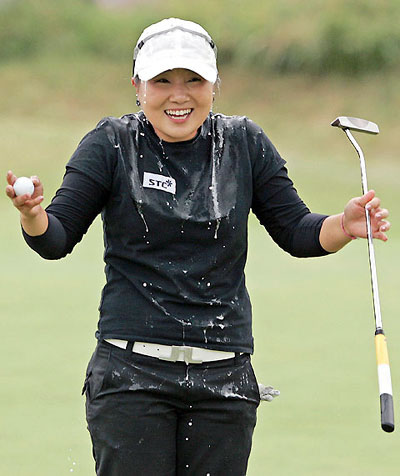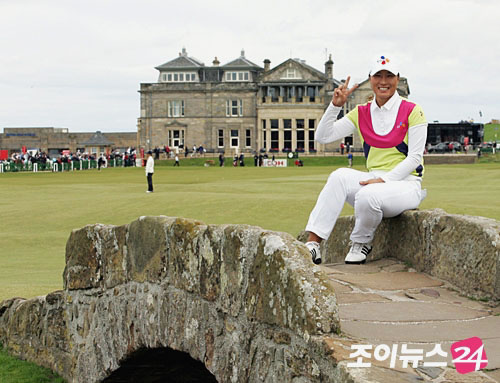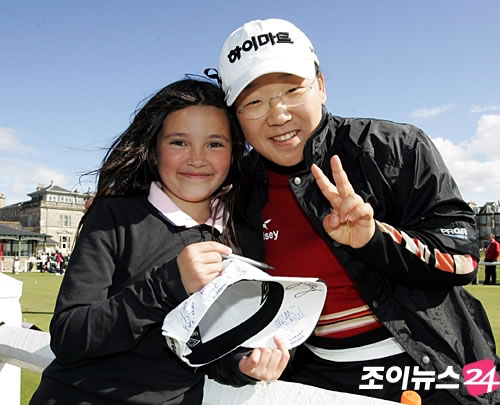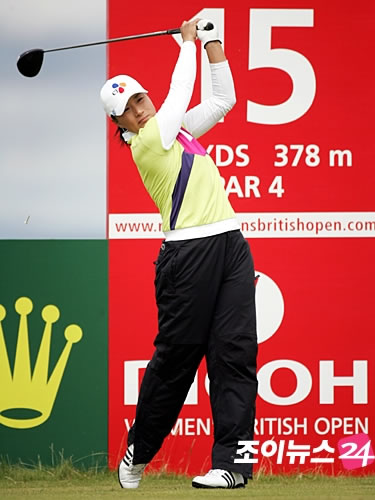 |
 |
 |
 |
 |
 |
2007 Ricoh Women's British Open:
Historic Week
 The
Women's British Open is the youngest of the four Majors the women play
each year, and the last one in the calendar year. It replaced the defunct
Du Maurier Classic in 2001 as a Major, although the LPGA had played it
as a regular tour event for several years before that. In the first year
as a Major, the Koreans swept the top two positions on the podium, with
Se Ri Pak roaring from behind to capture the title while Mi Hyun Kim settled
for second place. This is still Kimmie's best finish at a Major, and in
fact, she has had very little success at this tournament since then, missing
the cut every year since 2003. Another Korean who has done quite well
here has been Jeong Jang (pictured), who seemed to contend often in the
windy conditions that are common at this event. She finally gained her
breakthrough win on the LPGA tour in a Major way at this very event: she
seized the lead in the first round of the 2005 edition and held it tenaciously
for four rounds, in the end winning by four shots.
The
Women's British Open is the youngest of the four Majors the women play
each year, and the last one in the calendar year. It replaced the defunct
Du Maurier Classic in 2001 as a Major, although the LPGA had played it
as a regular tour event for several years before that. In the first year
as a Major, the Koreans swept the top two positions on the podium, with
Se Ri Pak roaring from behind to capture the title while Mi Hyun Kim settled
for second place. This is still Kimmie's best finish at a Major, and in
fact, she has had very little success at this tournament since then, missing
the cut every year since 2003. Another Korean who has done quite well
here has been Jeong Jang (pictured), who seemed to contend often in the
windy conditions that are common at this event. She finally gained her
breakthrough win on the LPGA tour in a Major way at this very event: she
seized the lead in the first round of the 2005 edition and held it tenaciously
for four rounds, in the end winning by four shots.
The British Open may be young, but it is also quickly establishing itself as one of the most prestigious events on tour. In part this is because of the quality of players who have generally won the tournament (the first three winners were Pak, Karrie Webb and Annika Sorenstam; at the 2003 edition, Se Ri and Annika waged a classic battle for the title before Sorenstam closed Se Ri out on the final hole). But no doubt part of it is the fact that the ladies are playing on many of the same courses that the men's British Open has been played on, classic courses like Turnberry, Sunningdale and Royal Birkdale.
Until this year, there was one extermely important British course that
was notably absent from the rotation of courses the women have been playing:
St. Andrews. This is not too surprising, as this course has never hosted
a professional women's event in its 500+ year history. But a few years
ago, the powers-that-be at the Old Course decided to allow history to
happen, and designated 2007 as the first year the women would play their
fourth Major at the hallowed ground where the sport of golf was born.
All year, the women have been buzzing about the chance to at last play
this almost mystical course, where almost every hole has its legends and
its iconic landmarks. The most famous hole of all is probably the 17th
hole, known as the "Road Hole". This hole requires a drive over
a shed that must be pretty intimidating for a weekend hacker who plays
the course; with the event on the line, it could cause even a seasoned
pro to pause. After landing in the fairway, the approach is to a tricky
green, but if you hit it too far offline, beware the dreaded Road Hole
bunker, a massive pit off to the side of the hole that has broken many
a professional's heart over the years. The men play this 450 yard hole
as a par 4, and it is often called the hardest hole in all of golf. The
organizers made it a par 5 for the ladies, but they would be playing from
the same tees as the men, so there would be a great chance to compare
how the two sexes play the same hole. The women acquitted themselves quite
nicely as it turned out, at times coming close to the scoring average
there the men posted.
 After
finishing that hole, play next moves to the short 18th hole where, after
a drive, players cross the famous "Swilcan Bridge", a small
stone bridge over the only water hazard on the course. Golfers have traditionally
posed on the bridge to commemorate their play on the course, and the ladies,
including Se Ri Pak, took full advantage of the opportunity to get a photo
at the landmark.
After
finishing that hole, play next moves to the short 18th hole where, after
a drive, players cross the famous "Swilcan Bridge", a small
stone bridge over the only water hazard on the course. Golfers have traditionally
posed on the bridge to commemorate their play on the course, and the ladies,
including Se Ri Pak, took full advantage of the opportunity to get a photo
at the landmark.
St. Andrews is a links style golf course, meaning that the weather conditions
have a major effect on how a player approaches the course. It is said
that no two rounds on the Old Course are ever the same thanks to the unpredictable
Scottish weather. Wind is common, and it can get both rainy and cold there.
The course is almost entirely flat, and dotted with deep pot bunkers that
are small but deadly. If a player lands in one, forget about going for
the green; priority one is getting out of it and scrambling to make par.
The player who avoids those bunkers the best would be a good bet to take
the trophy. On many holes, the green is shared with that of another hole,
so it would be possible to be landing on a part of the green that was
nearer to another hole's flag than the hole one was actually playing.
The greens are huge, and putts in excess of 100 feet in length are not
so unlikely. In fact, it's hard at times to tell the difference between
the fairway and the green, and many players will putt from 40 or 50 yards
in the fairway up to the green. In general, it is better to hit low running
shots than the high pinpoint pitches players are used to. This course
could prove to be a massive challenge for the women, particularly if the
wind kicked up as it is wont to do. They all couldn't wait to take it
on.
 The
Koreans, as usual, sent a strong group of players to compete. Besides
the usual top LPGA stars, several top KLPGA golfers were there to play,
including Ji-Yai Shin (pictured with a fan), coming off a third place
finish at the previous week's event, the Evian Masters (which should have
been good practice for the British, as it was quite windy there as well).
Eun-Hee Ji was also in the field, playing her first career LPGA Major;
she had notched a top 20 at the Evian, her first ever LPGA event. Also
present was Hye-Yong Choi, an amateur who had won the bronze medal at
the Asian Games in 2006, and was not to be confused with Hye Jung Choi,
who is a player on the LPGA tour, and who was also in the field this week.
Among the top contenders, Se Ri Pak and Jeong Jang had had the most success
at this event, while Mi Hyun Kim always seemed to struggle here (at times,
her only missed cut of the year would come at the British). Kimmie indeed
had been tempted to skip the tournament this year, but decided to come
solely because she wanted to play St. Andrews. She told the press that
she had only ever played the course on her PlayStation, but anticipated
it would be a different experience in real life, because on the video
game she hit 400 yard drives every time! Young Kim was another player
to watch, having notched several top tens in the British over her career,
including a tie for third in 2005. And Shin always seemed to be a factor,
so she was dangerous. Lastly, there was Jee Young Lee, a long bomber coming
off a lackluster Evian. Still, many felt length would be important on
this course, which was playing 6,600 yards for the women, very long for
a course at sea level. And if anyone among the Koreans had length, it
was Jee Young.
The
Koreans, as usual, sent a strong group of players to compete. Besides
the usual top LPGA stars, several top KLPGA golfers were there to play,
including Ji-Yai Shin (pictured with a fan), coming off a third place
finish at the previous week's event, the Evian Masters (which should have
been good practice for the British, as it was quite windy there as well).
Eun-Hee Ji was also in the field, playing her first career LPGA Major;
she had notched a top 20 at the Evian, her first ever LPGA event. Also
present was Hye-Yong Choi, an amateur who had won the bronze medal at
the Asian Games in 2006, and was not to be confused with Hye Jung Choi,
who is a player on the LPGA tour, and who was also in the field this week.
Among the top contenders, Se Ri Pak and Jeong Jang had had the most success
at this event, while Mi Hyun Kim always seemed to struggle here (at times,
her only missed cut of the year would come at the British). Kimmie indeed
had been tempted to skip the tournament this year, but decided to come
solely because she wanted to play St. Andrews. She told the press that
she had only ever played the course on her PlayStation, but anticipated
it would be a different experience in real life, because on the video
game she hit 400 yard drives every time! Young Kim was another player
to watch, having notched several top tens in the British over her career,
including a tie for third in 2005. And Shin always seemed to be a factor,
so she was dangerous. Lastly, there was Jee Young Lee, a long bomber coming
off a lackluster Evian. Still, many felt length would be important on
this course, which was playing 6,600 yards for the women, very long for
a course at sea level. And if anyone among the Koreans had length, it
was Jee Young.
This year, the event had a new sponsor, Ricoh, the Japanese copier company,
who picked up the reins of the tournament after Weetabix, who had sponsored
it for years, reluctantly ended their support. It should be pointed out
that those who condemn the Asian presence on tour conveniently forget
that sponsors like Ricoh probably would not be supporting events like
this were it not for the Japanese and Korean stars present on the LPGA.
 The
folks running the show decided that all players would start from the first
tee and end on the 18th every day, an unusual setup for any tournament.
This meant that play started very early and stretched until late in the
day. Fortunately, at this time of year, Scotland, with its northern latitude,
has daylight until fairly late at night. Among the players who started
very early on day one were Lorena Ochoa, the world's number one, and Se
Ri Pak. The conditions were fairly benign, and Ochoa took advantage, shooting
a blistering 6 under par 67 (remember, the course was par 73 thanks to
the par 5 on the Road Hole) to take an early lead. Alas, Se Ri did not
fare so well. She had skipped the Evian Masters with the express intention
of preparing for this event. She wanted above all else to win it and get
at least one Major in 2007. But on this day, she started with two early
bogies, before making a birdie on the 7th. She wound up shooting four
birdies and four bogies, scoring an even par 73 that left her well back
of the leaders. It was an opportunity wasted.
The
folks running the show decided that all players would start from the first
tee and end on the 18th every day, an unusual setup for any tournament.
This meant that play started very early and stretched until late in the
day. Fortunately, at this time of year, Scotland, with its northern latitude,
has daylight until fairly late at night. Among the players who started
very early on day one were Lorena Ochoa, the world's number one, and Se
Ri Pak. The conditions were fairly benign, and Ochoa took advantage, shooting
a blistering 6 under par 67 (remember, the course was par 73 thanks to
the par 5 on the Road Hole) to take an early lead. Alas, Se Ri did not
fare so well. She had skipped the Evian Masters with the express intention
of preparing for this event. She wanted above all else to win it and get
at least one Major in 2007. But on this day, she started with two early
bogies, before making a birdie on the 7th. She wound up shooting four
birdies and four bogies, scoring an even par 73 that left her well back
of the leaders. It was an opportunity wasted.
As the day stretched on, the conditions got rougher, and it became tougher for the later golfers to keep up with those who had started early. But a few later starters still managed to make a mark, and some of them were Korean. In-Bee Park had had a fairly weak 2007 season, but she had shown that she was quite capable of competing on a Major level course when she finished tied for 4th at the US Women's Open a few weeks earlier. She got out to a great start here, firing a 4 under par 69 to finish the day tied for second, just two shots behind Ochoa. Meena Lee has also struggled by her standards in 2007, but she shot a 71, 2 under par, to finish tied for 6th. Jee Young Lee, Sarah Lee, and rookies Na On Min and In-Kyung Kim all shot one under par 72s. Young Kim and Eun-Hee Ji both joined Se Ri with even par rounds. On the downside, several players who had looked good to contend coming into the event struggled on this day. Ji-Yai Shin really had problems, shooting a 3 over par 76 that left her in danger of missing her first cut, not just on the LPGA tour, but since she became a professional. Mi Hyun Kim continued her woeful ways at the British Women's Open with a 79, and Seon Hwa Lee, who had won the HSBC World Match Play less than a month earlier, shot a 76. Jeong Jang, the 2005 champion and usually an excellent wind player, shot a 76 herself. It was not the best of days for the Korean contingent.